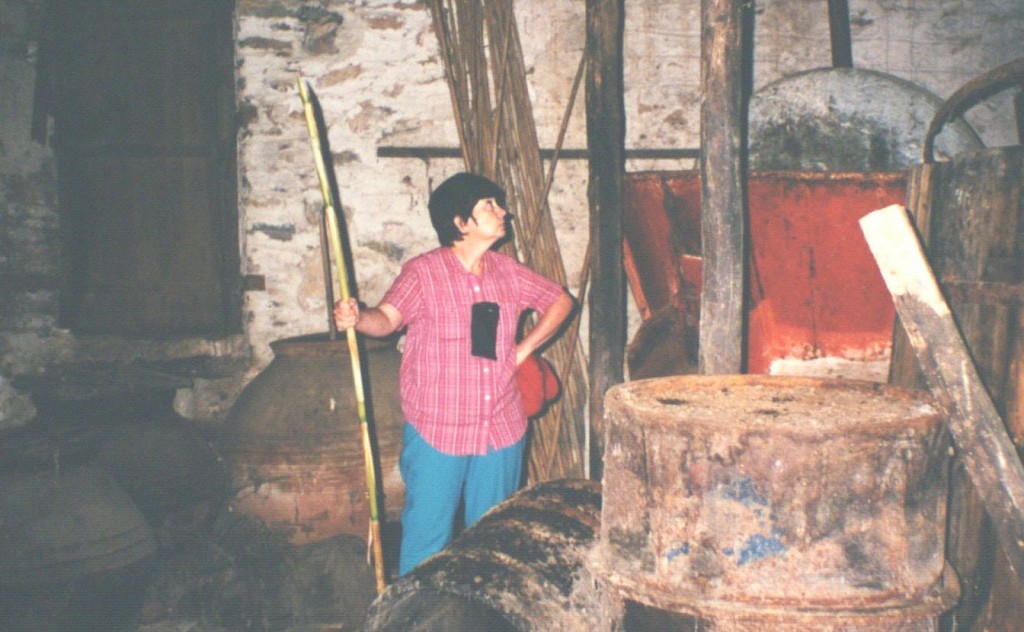I mentioned using our own olive oil in “Going Bananas”. Olive crops are notorious for being unpredictable, vulnerable as the fruit is to a great many factors, and it’s common to have a reasonable harvest every second year as a rule. The farmers, and particularly the older folk, say the trees are resting when it’s clear that no olives are developing on the trees, and who can blame them, the trees that is.
The olive tree grows slowly, taking its time. It’s been taking its time for aeons and there’s something about its gnarled trunk, its knotted branches knitted into intertwining twists and cables, its roots reaching over rocks and creeping into crevices, that’s very reassuring. Olive wood is extremely hard, the tree is evergreen. We live among olive groves that have been rooted for centuries in a land that has seen everything good and everything ghastly that mankind is capable of.
There’s much I could write about olives, but for now I’ll contrast the old way of pressing the fruit to obtain the golden oil with the very latest technology.
Deep in a secluded valley near our home lies a very old abandoned village whose handful of residents attempted to escape the depredations of invasions in times long gone. The few stone houses stand silently derelict amongst wildly overgrown orchards, formerly abundant with fruit, whilst the dense undergrowth strangles the artichokes and a few other vegetables, heirs to earth once cultivated, which have managed to propagate. But the olive trees endure. Untended, unpruned, unfed and unharvested they stand in silent testimony.
Amongst the ruins are the remains of the olive mill which produced the oil upon which the villagers and other locals relied. The olives would have been brought by donkey and stored in the ceramic jars whose design has changed not at all over many, many centuries, until their turn to be weighed and then pressed. The harvest was a busy time for everybody, backbreaking work, even for small children who would collect the olives which were knocked from the trees to the ground. I’m sure all would have been delighted to see the oil flowing from those presses, just as we never fail to be thrilled when we see our oil gushing from the gleaming stainless steel of the very latest equipment.
![IMG_1025 [HDTV (720)]](http://chasingcentaurs.com/wp-content/uploads/2015/02/IMG_1025-HDTV-720.jpg)
![IMG_1026 [HDTV (720)]](http://chasingcentaurs.com/wp-content/uploads/2015/02/IMG_1026-HDTV-720.jpg)
![IMG_1027 [HDTV (720)]](http://chasingcentaurs.com/wp-content/uploads/2015/02/IMG_1027-HDTV-720.jpg)
![IMG_1389 [HDTV (720)]](http://chasingcentaurs.com/wp-content/uploads/2015/02/IMG_1389-HDTV-720.jpg)
![IMG_1029 [HDTV (720)]](http://chasingcentaurs.com/wp-content/uploads/2015/02/IMG_1029-HDTV-720.jpg)
![IMG_1031 [HDTV (720)]](http://chasingcentaurs.com/wp-content/uploads/2015/02/IMG_1031-HDTV-720.jpg)
![IMG_1034 [HDTV (720)]](http://chasingcentaurs.com/wp-content/uploads/2015/02/IMG_1034-HDTV-720.jpg)
![IMG_1028 [HDTV (720)]](http://chasingcentaurs.com/wp-content/uploads/2015/02/IMG_1028-HDTV-720.jpg)
![IMG_1030 [HDTV (720)]](http://chasingcentaurs.com/wp-content/uploads/2015/02/IMG_1030-HDTV-720.jpg)
![IMG_1033 [HDTV (720)]](http://chasingcentaurs.com/wp-content/uploads/2015/02/IMG_1033-HDTV-720.jpg)

Today every last drop is squeezed from the olives, although the method of harvesting the fruit is essentially the same – the olives still have to be beaten out of the trees. My friend Petra made this video at harvest time last year and it shows the whole process of olive oil production very clearly.
Video by Petra Nowak; music written and composed by loVeu2 (Nowak, Georgiou, Elliot)

![IMGP4082 [1024x768]](http://chasingcentaurs.com/wp-content/uploads/2015/02/IMGP4082-1024x768-1024x588.jpg)
![P1120144 [HDTV (1080)]](http://chasingcentaurs.com/wp-content/uploads/2015/02/P1120144-HDTV-1080-768x1024.jpg)
![P1120827 [HDTV (1080)]](http://chasingcentaurs.com/wp-content/uploads/2015/02/P1120827-HDTV-1080-1024x636.jpg)
![P1120626 [HDTV (1080)]](http://chasingcentaurs.com/wp-content/uploads/2015/02/P1120626-HDTV-1080-1024x664.jpg)
![P1120624 [HDTV (1080)]](http://chasingcentaurs.com/wp-content/uploads/2015/02/P1120624-HDTV-1080-1024x716.jpg)
![P1110799 [HDTV (1080)]](http://chasingcentaurs.com/wp-content/uploads/2015/02/P1110799-HDTV-1080-1024x607.jpg)
![IMG_1036 [HDTV (720)]](http://chasingcentaurs.com/wp-content/uploads/2015/02/IMG_1036-HDTV-720.jpg)
![IMGP4168 [HDTV (1080)] [1024x768]](http://chasingcentaurs.com/wp-content/uploads/2014/10/IMGP4168-HDTV-1080-1024x768.jpg)
![IMGP4170 [HDTV (1080)] [1024x768]](http://chasingcentaurs.com/wp-content/uploads/2014/10/IMGP4170-HDTV-1080-1024x768.jpg)
![P1220805 [HDTV (1080)]A](http://chasingcentaurs.com/wp-content/uploads/2014/09/P1220805-HDTV-1080A.bmp)
![P1050295 [HDTV (720)]A](http://chasingcentaurs.com/wp-content/uploads/2014/09/P1050295-HDTV-720A-300x105.jpg)
![P1050318 [HDTV (720)] [HDTV (720)]A](http://chasingcentaurs.com/wp-content/uploads/2014/09/P1050318-HDTV-720-HDTV-720A-300x211.jpg)
![P1050315 [HDTV (720)]A](http://chasingcentaurs.com/wp-content/uploads/2014/09/P1050315-HDTV-720A-300x238.jpg)
![P1050308 [HDTV (720)]A](http://chasingcentaurs.com/wp-content/uploads/2014/09/P1050308-HDTV-720A-300x203.jpg)
![P1050356 [HDTV (720)]A](http://chasingcentaurs.com/wp-content/uploads/2014/09/P1050356-HDTV-720A-300x255.jpg)
![P1220586 [HDTV (1080)]A](http://chasingcentaurs.com/wp-content/uploads/2014/09/P1220586-HDTV-1080A-300x153.jpg)
![P1190463 [HDTV (1080)]](http://chasingcentaurs.com/wp-content/uploads/2014/09/P1190463-HDTV-1080-300x225.jpg)
![P1130039 [HDTV (1080)]](http://chasingcentaurs.com/wp-content/uploads/2014/09/P1130039-HDTV-1080-300x179.jpg)